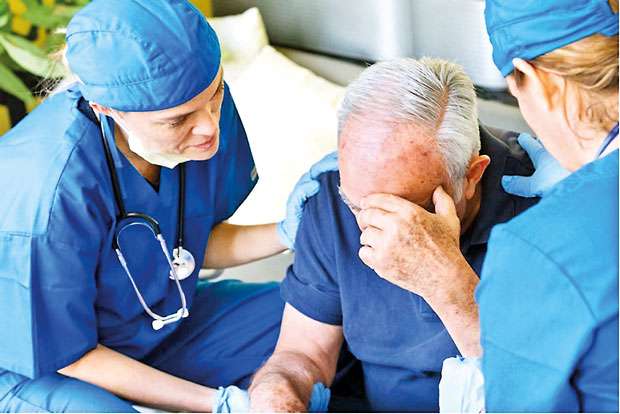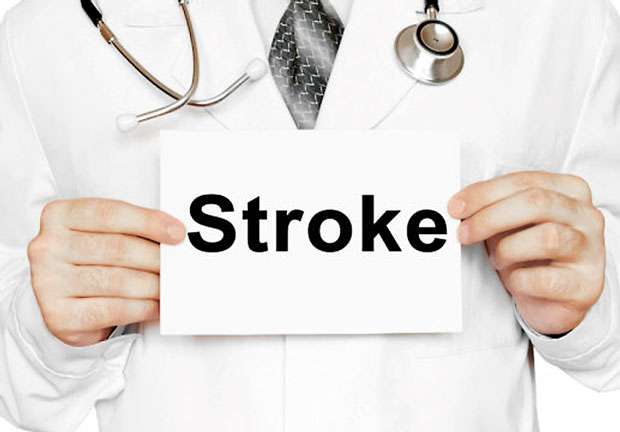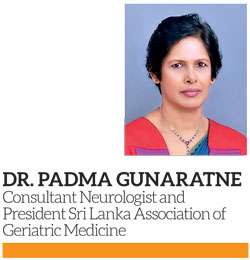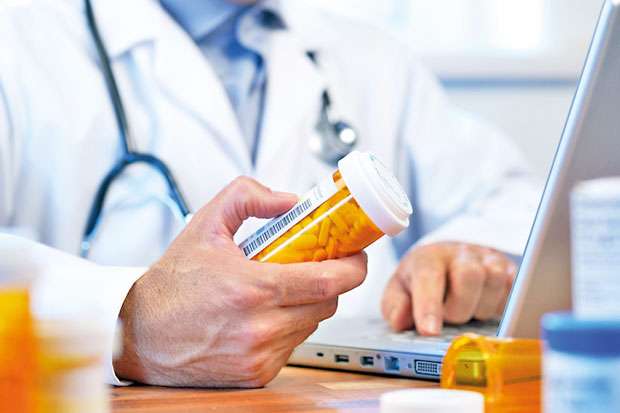02 Nov 2018 - {{hitsCtrl.values.hits}}

 A healthy blood supply is necessary for organs of the human body to function well. But what happens if the blood supply to the brain is interrupted? That is when a stroke occurs, cutting off much needed oxygen and nutrients provided by blood, enabling proper brain function. A stroke is a serious medical emergency, which injures the brain and can leave victims with long-term disabilities.
A healthy blood supply is necessary for organs of the human body to function well. But what happens if the blood supply to the brain is interrupted? That is when a stroke occurs, cutting off much needed oxygen and nutrients provided by blood, enabling proper brain function. A stroke is a serious medical emergency, which injures the brain and can leave victims with long-term disabilities.
Dr. Padma Gunaratne, Consultant Neurologist and President Sri Lanka Association of Geriatric Medicine, notes that this disturbance of the blood supply to the human brain often takes place suddenly. “Vessels carrying blood to the brain could either suddenly get blocked or they may burst and bleed into the brain. Based on which blood vessel is blocked there will be an area of the brain without blood supply. As different parts of the brain are specialised for varying functions, if the blood supply to any of these areas is disturbed, then the functions of that particular area, which could be speech or vision for instance, will be disrupted. These are the set of symptoms we describe as stroke,” Dr. Gunaratne explains.
The disturbance of blood supply could happen due to two reasons. One is when the blood vessel is blocked, resulting in what is known as Ischemic Stroke. The other is when a weakened blood vessel bursts causing bleeding into the brain. This is called the Haemorrhagic Stroke where the area in the brain in which blood occupies gets damaged so that you develop symptoms. In both Ischemic Stroke and Haemorrhagic Stroke you develop symptoms alike.
What is a silent stroke?
Symptoms of stroke appear based on the area of the brain which is affected. However in some strokes, the symptoms are almost unnoticeable. “For instance, speech is something prominent in humans. In the majority, speech is a domain of the left brain. If your left brain is damaged, then you develop symptoms like weakness and speech disturbance. Strokes in the left brain are therefore more likely to appear with symptoms,” Dr. Gunaratne explains.
If you develop symptoms only for a very short period, we identify it as a mini stroke or Transient Ischemic Attack. Nevertheless, this is a retrospective diagnosis. The patient should completely improve for us to identify that the patient had a Transient Ischemic Attack
However according to the expert neurologist, if the right brain is damaged, there are many areas that could be silent. “In some cases, a blood vessel in the brain may be blocked but because that area of the brain is not significant or because the affected area is so small, you may not develop symptoms. If a person has had a stroke without causing symptoms, then we call it a silent stroke,” she says.

Symptoms
Symptoms of a stroke could appear in two ways. In some, symptoms appear for a very short period (about one hour) before they would settle. If the block is dissolved, the blood supply would be restored. If this happens, Dr. Gunaratne opines that a patient is likely to improve completely. “If you develop symptoms only for a very short period, we identify it as a mini stroke or Transient Ischemic Attack. Nevertheless this is a retrospective diagnosis. The patient should completely improve for us to identify that the patient had a Transient Ischemic Attack. The patient’s likelihood to improve depends on the severity of injury. Patients are at their worst during the peak of the illness within the first few days following the stroke, before they gradually start improving. If symptoms persist for longer than 24 hours, then we identify it as a stroke,” Dr. Gunaratne opines.
Is everyone at risk?
Some of us are more vulnerable to a stroke, according to the expert. “Within the community in Colombo and suburbs, one out of every ten has suffered a stroke. Stroke deaths are under-reported especially from peripheries in Sri Lanka. Hospital deaths indicate that it is the fourth leading cause of disability in the country although in many countries it is the second leading cause of death,” Dr. Gunaratne notes. According to Dr. Gunaratne it is likely that Sri Lanka too belongs to the category where stroke related deaths are high, especially because our elderly population is rapidly rising. She warns of a high risk of stroke particularly among the elderly.
Asked of preventive measures to consider, Dr. Gunaratne said that many develop issues due to atherosclerosis which is the thickening of blood vessels. “There are many lifestyle interventions that could be implemented to bring down the prevalence of stroke,” she adds.
Advanced age, diabetes, high blood pressure, cholesterol, consumption of tobacco and alcohol as well as an unhealthy diet coupled with a lack of exercise are the leading risk factors enabling strokes. Meanwhile Dr. Gunaratne adds, South East Asians are more vulnerable to developing strokes as rates of diabetes and high blood pressure are higher among these groups. Dr. Gunaratne says that patients suffering from heart related ailments are also likely to develop a stroke. “We need to consider them as high risk patients and intervene to bring down that risk as much as possible,” she warns.
One of the most important preventive measures according to Dr. Gunaratne is to develop the skill of recognising the illness. “If you recognise a symptom only, will you be able to act appropriately. If you have recognised it, you need to rush to hospital because there are medicines that could be given to dissolve a clot. By acting promptly you reduce the risk of a person developing another stroke,” the neurologist underscores.
Recent figures have revealed another interesting aspect of stroke prevalence in Sri Lanka. “According to the stroke registry we have registered more than 1,000 stroke admissions per year at all major hospitals such as the Teaching Hospitals of Colombo, Colombo South, Kandy, Karapitiya and Jaffna. We found that at every age category, more men are admitted to hospitals than women, except in the above 80 category. This is because women live longer than men and therefore the women in this category are more vulnerable to develop stroke,” she highlights.

Management of patients
Dr. Gunaratne underscores that the health sector could do more to improve care for stroke patients. “80% of strokes could be prevented. Once they develop a stroke another 70% of them could be very successfully treated. Therefore it’s very important that people are aware of preventive measures,” she says.
Regular assessments for blood pressure, sugar and cholesterol levels along with a healthy diet and exercise would significantly contribute to a healthy lifestyle. “Smoking and alcohol consumption should be completley stopped while patients should continue their treatment for existing ailments, especially of the heart,” she cautions.
When a stroke occurs, the patient must immediately visit the closest and biggest hospital. “For the management of stroke patients need a CT scan. An injection is given to selected patients with blocks in vessels, in order to dissolve the clot. For instance a person in Colombo has to either go to the Sri Jayawardenapura National Hospital or Colombo South Teaching Hospital, because the injection is available in such hospitals only. Furthermore the injection is given only within 4.5 hours from the onset of stroke. It requires extensive investigation and costs the government more than Rs. 100,000. So if you are to receive the injection as well as the highest benefits of these expensive and specific treatments, you have to reach the hospital as early as possible, “ she notes. “A patient would come to the hospital fast, only if they know to diagnose the clues. If they come beyond this time period, we are unable to give this injection. There has to be knowledge and understanding,” Dr. Gunaratne adds.
According to Dr. Gunaratne, stroke patients have to be managed in a stroke unit highlighting the importance of every hospital being equipped with such a unit. All resources should be concentrated to this ward to give the best possible care for patients. “A specialised set of nurses, Occupational Therapists, Speech Therapists, Physiotherapists, Social Service Officers allocated from the ministry of social services as well as a counsellor should be working in this ward. Their objective is to cure the patient and where that is not possible to make the patient independent, “ Dr. Gunaratne notes.
If you have suffered a stroke or if you are a caregiver for a stroke victim, consider attending the Stroke Support Group Meetings, taking place on the last Saturday of every month at 9 am at the National Epilepsy Centre, NHSL. All patients and caregivers can walk into these meetings where they could receive advise from therapists as well as share the knowledge of other patients who have improved with coping strategies.
22 Dec 2024 1 hours ago
22 Dec 2024 2 hours ago
22 Dec 2024 2 hours ago
22 Dec 2024 6 hours ago
22 Dec 2024 8 hours ago